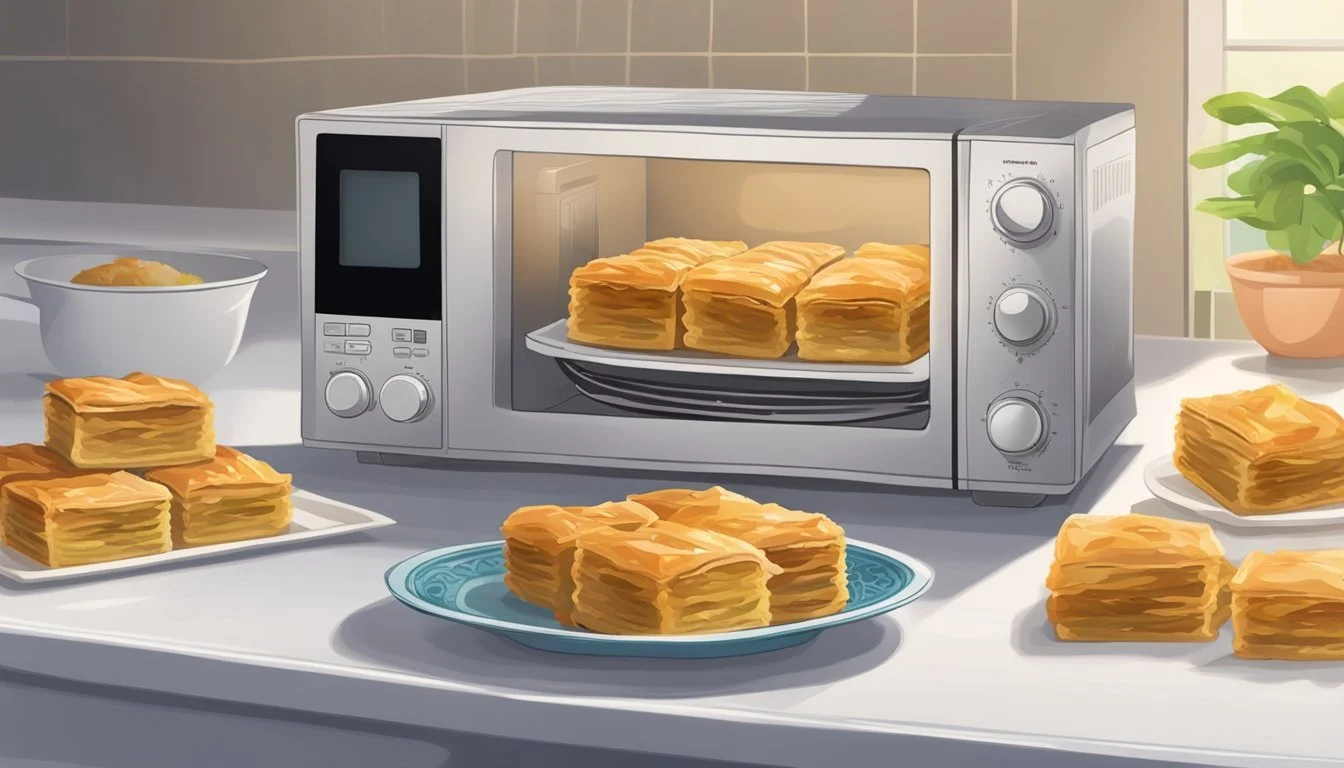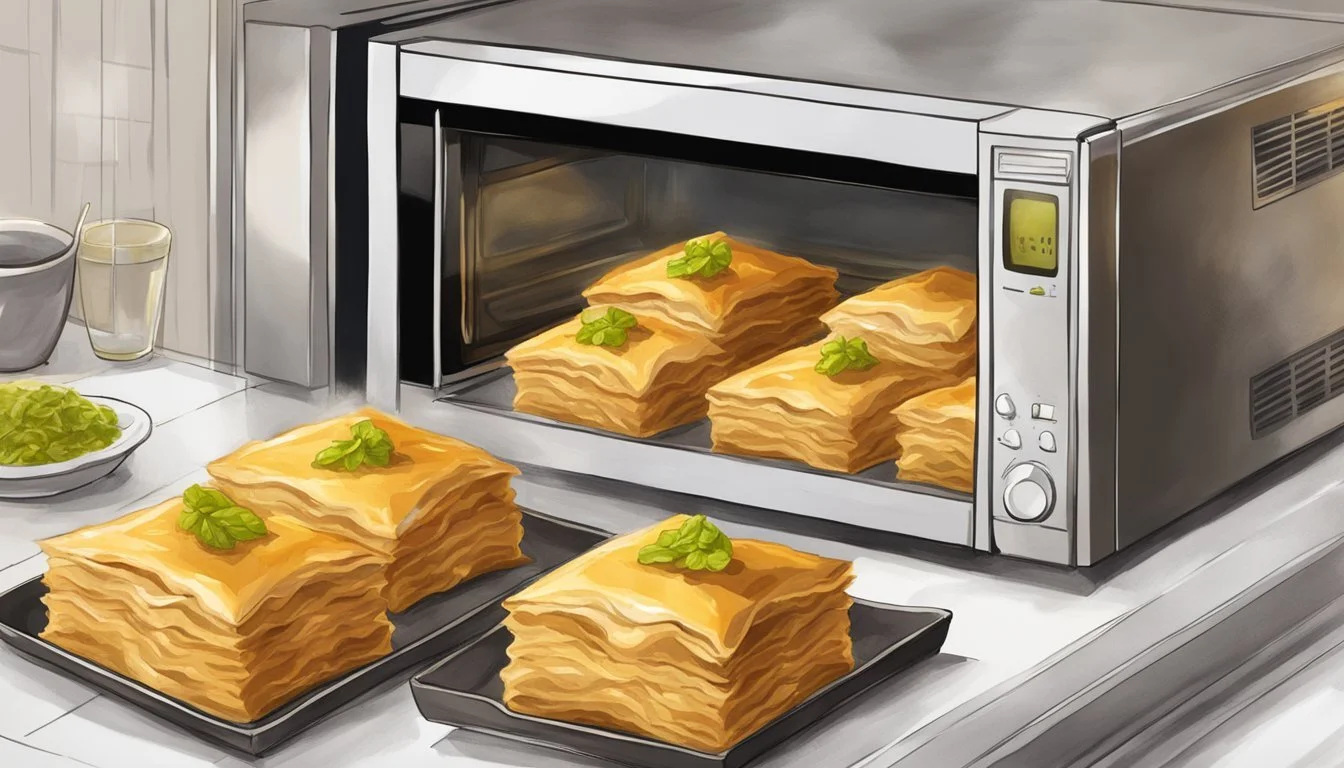Best Way to Reheat Baklava
Ensuring Flaky Pastry and Moist Filling
Baklava, with its origins in the Middle East, has global recognition for its sweet, nutty layers encased in flaky phyllo pastry. Achieving the perfect reheating of baklava is as much an art as its creation. The goal is to maintain the crisp texture of the pastry without drying out the nut filling, preserving the moisture of the sweet syrup or honey that permeates its layers.
With its versatility and adaptability to various nuts and spices, baklava makes for a beloved treat. However, it presents a unique challenge when it comes to reheating leftovers while keeping its structural integrity intact. Connoisseurs and casual fans alike may agree that restoring baklava to its original state of warm, crispy outer layers with a moist and flavorful center is essential for an enjoyable experience.
Understanding Baklava
Baklava is a rich, sweet pastry celebrated for its layers of flaky phyllo and decadent nut filling, typically cut into various shapes and famously drenched in sweet syrup or honey.
Composition and Texture
The essence of baklava lies in its composition and contrasting textures. Delicate sheets of phyllo pastry, thin unleavened dough, are meticulously layered, with each sheet traditionally brushed with butter. These layers form the flaky, crisp exterior that houses the moist interior.
Phyllo Pastry: Central to baklava's structure, giving it a light, airy crispness.
Nut Filling: A fragrant mixture of chopped nuts like pistachios and walnuts, often bound together with sweeteners.
The texture varies from the topmost crunchy sheets to the tender, enriched bottom layers soaked in syrup.
Traditional Ingredients
The filling and flavoring components of baklava speak directly to its traditional ingredients.
Nuts: Minutely chopped, they are the heart of the filling with popular choices being pistachios and walnuts.
Sweet Syrup: The baklava is finished with a generous amount of syrup, typically made with sugar and sometimes with honey, ensuring the pastry is indulgently moist.
Spices: Cinnamon is a commonly used spice, adding warmth and complexity to the nutty filling.
These ingredients combine to create a dessert (What wine goes well with desserts?) that is not only rich in texture but also in flavor, making each bite of baklava an experience of layered sweetness and crunch.
Storing Baklava for
Reheating Techniques
Reheating baklava properly can make a significant difference in preserving its flakiness and moisture. The key is to retain the pastry's original texture and taste.
Preparation Before Reheating
Before reheating, it's important to allow the baklava to reach room temperature, especially if it has been refrigerated or frozen. This step ensures even reheating and helps restore the pastry’s texture. For frozen baklava, it should be thawed in the refrigerator for at least 6 hours. Place the baklava on a baking pan lined with parchment paper, to prepare for the reheating process.
Using the Oven
Reheating baklava in the oven is the most effective method to achieve a crisp texture and warm filling.
Preheat your oven to 300 degrees Fahrenheit.
Remove the baklava from the refrigerator and let it sit at room temperature for about 30 minutes.
Cover the baklava loosely with aluminum foil to prevent the top from burning.
Place the baklava in the preheated oven.
Heat for about 10-15 minutes. Check intermittently to ensure it does not overcook.
By following these steps, baklava can regain its desirable crispiness without drying out.
Microwave Method
While not ideal, the microwave can be used for a quick reheat.
Place the slice of baklava on a microwave-safe plate.
Cover it with a paper towel to absorb excess moisture.
Heat on a low setting for 10 to 15 seconds.
Using a microwave may not preserve the flakiness as well as the oven, but it’s a quick alternative if time is a constraint. The key is to reheat in short intervals to prevent the baklava from becoming too soft or soggy.
Ensuring Perfect Texture
To achieve the ideal balance of crispiness and moisture when reheating baklava, one must treat the flaky phyllo with care and ensure that the filling remains moist.
Tips for Flaky Phyllo
Phyllo dough, known for its delicate layers, can become soggy if not handled correctly. Reheating baklava in an oven preheated to 350 degrees Fahrenheit is recommended. It is crucial to cover the baklava with foil to protect the phyllo and prevent it from burning. A brief time in the oven—typically around 10 to 15 minutes—is sufficient. The goal is to restore the pastry's warmth and flakiness without overbaking.
Note:
Phyllo Dough: Handle with care; keep covered with foil while reheating.
Oven Temp: Preheat to 350°F.
Time: 10-15 minutes.
Maintaining Moist Filling
The filling should emerge from the reheating process as moist as when the baklava was first served. To preserve the filling's moisture, ensure the baklava has cooled completely at room temperature after the initial baking and before storage. Additionally, using melted butter during the initial layering will help seal in the filling's moisture during reheating.
Note:
Cooling: Allow to cool completely before storing.
Melted Butter: Use in the initial preparation to maintain moisture.
Serving and Presentation
When presenting baklava, one must aim for both aesthetic appeal and maintenance of its textural integrity. Serving baklava involves precise cutting and thoughtful addition of garnishes that complement the dessert's rich flavors.
Cutting and Plating
The slicing of baklava is optimally done with a sharp knife to ensure clean cuts and preserve the delicate layers. Traditionally, baklava is cut into diamond shapes which not only makes for an attractive presentation but also allows for even portions. When plating, using a flat spatula can help in transferring the pieces onto plates without causing the layers to crumble or stick.
Adding Final Touches
Once plated, adding a final touch of garnish can enhance the visual appeal and add subtle flavor nuances. A light dusting of powdered sugar or a sprinkle of finely chopped pistachios can be aesthetically pleasing. If serving baklava warm, one should ensure that any syrups or toppings are applied just before serving to prevent sogginess and to showcase the pastry's crisp texture.
Creating Your Own Baklava
Crafting homemade baklava allows for a celebration of flavors and textures. The process involves layering flaky pastry with a variety of nut mixtures, securing them with sweet syrups, and could range from traditional Greek baklava to modern variants with unique twists.
Homemade Baklava Variations
Different regions have their own take on baklava, with variations typically focusing on the choice of nuts and syrups:
Greek Baklava: Often uses a mixture of walnuts, cinnamon, and honey.
Pistachio Baklava: Popular in Middle Eastern versions, this variant is rich in pistachios.
Honey Baklava: Emphasizes honey in the syrup for a sweet and sticky experience.
The flexibility in the recipe allows bakers to experiment with spices, nuts, and syrups, which can include rose water or orange blossom water for additional flavor.
Baklava Recipe Breakdown
Ingredients:
1 package of phyllo dough
4 cups of finely chopped nuts (walnuts, pistachios, or a combination)
1 cup of melted unsalted butter
1 teaspoon of ground cinnamon
Syrup:
1 cup of water
1 cup of sugar
1/2 cup of honey
1 cinnamon stick
1 strip of lemon peel
Preparation:
Preheat the oven to 350°F (175°C).
Brush a baking pan with melted butter. Lay out phyllo sheets, buttering generously between each layer.
After several sheets, spread a layer of the nut mixture. Repeat phyllo layering and nut mixture until all is used, finishing with a top layer of phyllo.
Slice the baklava into diamonds or squares before baking.
Bake for about 50 minutes or until golden and crisp.
Syrup Application:
While baklava bakes, combine water, sugar, honey, cinnamon stick, and lemon peel in a saucepan.
Bring to a boil, then simmer for about 20 minutes.
Once the baklava is baked, pour the hot syrup over the hot pastry.
Let it cool completely to allow the syrup to soak in and the layers to set.
Striking the perfect balance between the flaky phyllo dough and the moist filling is the key to an excellent baklava result, making for a rich and satisfying dessert.





